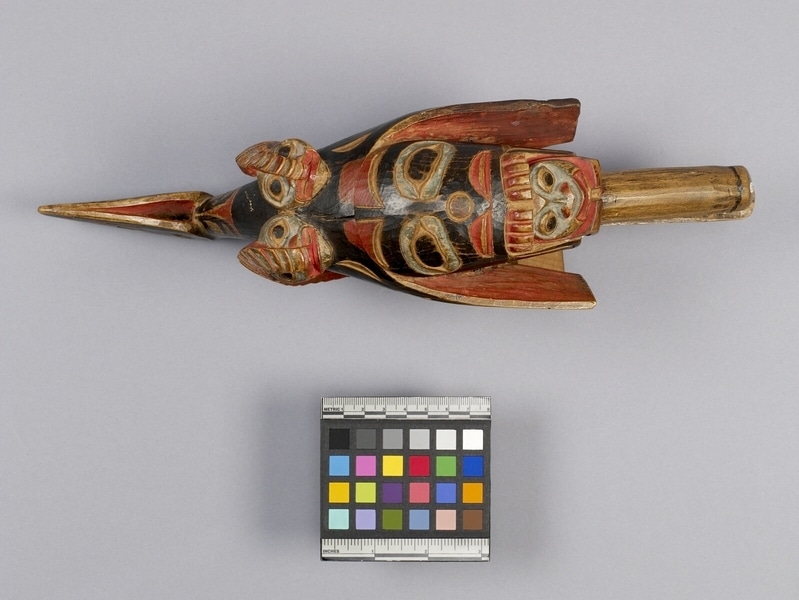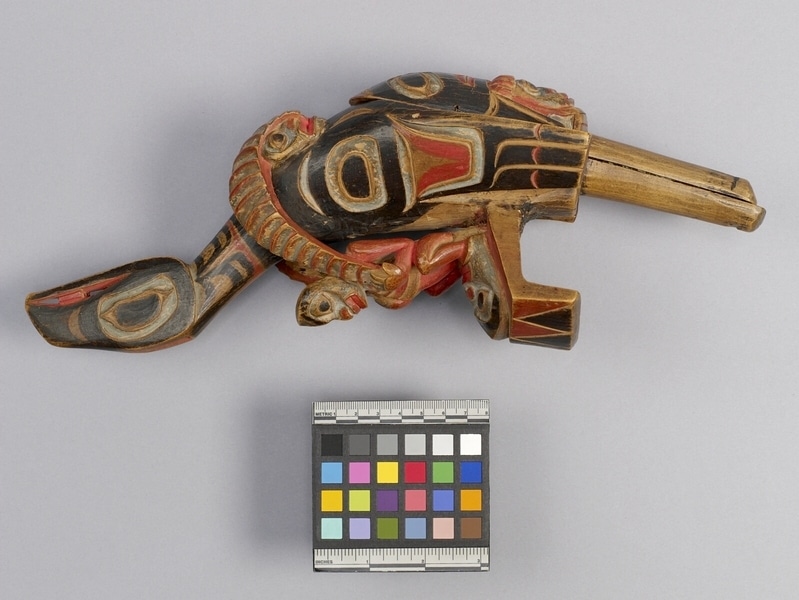Raven Rattle Item Number: A5254 from the MOA: University of British Columbia




Description
Hardwood rattle. Two complementary parts in from of a raven. The raven’s body is strongly curved, and its wings are folded; an unusual triangular pattern marks the tail. Reclining figure on a raven's back – likely a shaman, indicated by the prominent ribs. The whole is dominated by the long, serrated forms extending upward from two small side-by-side faces on the raven’s chest, reaching over the raven’s breast and into the hands of the human. On the raven’s belly is carved the stylized face of the supernatural being, with a small humanlike face below emerging from beneath the raven’s feet, a representation of the bird’s cloaca. Tied together with brass wire. (Interior likely holds pebbles, beads or lead shot.)
Cultural Context
ceremonial
Narrative
There are significant differences, beyond stylistic ones, that mark this rattle as a unique belonging used in Tlingit shamanic practice rather than being a component of chiefly regalia. Rattles that were the exclusive tools of individual Tlingit ixt’ – shamans or healers – are understood to represent more private encounters with spirit powers and supernatural realms. Here the raven’s body is more strongly curved than is typical, and its wings are folded rather than outstretched; an unusual triangular pattern marks the tail. More importantly, the entire tableau on the back of the raven has been transformed from more common arrangements, excepting the reclining human – likely representing a shaman, as indicated by the prominent ribs. The whole is dominated by the long, serrated forms extending upward from two small faces on the raven’s belly, reaching over the raven’s breast and into the hands of the human. Their curved shape and prominent ridges seem to suggest mountain-sheep horns, yet their placement as tongues is also like an exaggerated representation of the ridged land-otter tongues depicted on another kind of bird rattle – named after the long-billed oystercatcher – that was often part of shamans’ gear. A shaman could acquire the land otter and other animals as helping spirits by cutting out their tongues. On the raven’s belly is carved the stylized face of the supernatural being characteristic of most raven rattles; the additional presence of a small humanlike face below, emerging from beneath the raven’s feet, hints at an aspect again more typical of oystercatcher than raven rattles: representation of the bird’s cloaca.
Item History
- Made in Alaska, USA between 1870 and 1890
- Owned by Walter C. Koerner before 1972
- Received from Walter C. Koerner (Donor) during 1972
What
Who
- Culture
- Tlingit
- Previous Owner
- Walter C. Koerner
- Received from
- Walter C. Koerner (Donor)
Where
- Holding Institution
- MOA: University of British Columbia
- Made in
- Alaska, USA
When
- Creation Date
- between 1870 and 1890
- Ownership Date
- before 1972
- Acquisition Date
- during 1972
Other
- Condition
- fair
- Accession Number
- 0160/0006